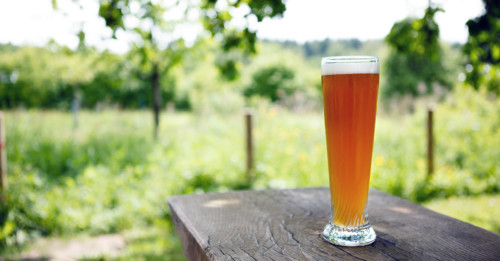Weissbier, aka Weizenbier, aka Weißbier is a larger category of German wheat beers, related to American Wheat Ales and Belgian Witbier. If you’ve been to a German beer hall recently, chances are you’ve encountered a Weissbier (and probably heard some good Oompah music, too). All Weissbiers are top-fermented (ale style, that is), brewed with a special strain of yeast that lends some pretty unique flavors to the finished beer, which will vary depending on the style.
Hefeweizen Essential Info
- Color: Pale golden to gold; cloudy
- ABV: 4.5%-6%
- Commercial Examples: Weihenstephaner Hefeweissbier Paulaner Hefe-Weissbier, Spaten Franziskaner Hefe-Weisse
A classic German wheat ale, made with a high ratio of wheat in the grain bill. The “hefe” in the name means yeast, indicating that the yeast hasn’t been filtered out—which is why these beers come at you cloudy and delicious (and a bit extra nutritious, bonus points!). Flavors will range from malty and bready to fruity, with few noticeable hop characteristics (especially bitterness). The most important flavors here come from the use of a special yeast—Torulaspora delbrueckii, ahem—which imparts classic Hefeweizen flavors like banana, clove, and even bubblegum. Bottle conditioning means you’ll get lively bubbles to lift up all this flavor.
Kristalweizen Essential Info
- Color: Clear to dark gold
- ABV: 4.5%-6%
- Commercial Examples: Weihenstephaner Kristall Weissbier, Jacob Leinenkugel Honey Weiss
Kristalweizen is what you get when you filter the yeast (or “hefe”) out of a Hefeweizen. Of course it’s not just the same thing but clearer (like Crystal Pepsi). Removing the yeast will impact some of the resulting flavor, especially since that special yeast strain imparts such distinctive flavors. Basically you’ll get a bit less of the banana, clove, bubblegum, etc., you’d get in a Hefeweizen, with a cleaner, crisper mouthfeel.
Dunkelweizen Essential Info
- Color: Copper to rich brown; often cloudy
- ABV: 4.5%-6.5%
- Commercial Examples: Weihenstephaner Hefeweissbier Dunkel, Erdinger Weissbier Dunkel, Sam Adams Dunkelweizen
A darker Hefeweizen (“dunkel” just means dark!), with roots in the dark wheat beer culture of Bavaria, with a high component of wheat that’s complemented by Munich or Vienna Malts. The same special yeast strain is used in Dunkelweizen as Hefeweizen—Torulaspora delbrueckii, though you probably don’t have to memorize that—so notes of banana and clove especially will still be there, rounded out with the bready, malty character of the beer with possible hints of caramel. Hops won’t really be noticeable at all, nor should there be any roastiness, as in a Stout, though a subtle tartness might peek through leading to a pretty dry finish. This style is about balancing some nice rich, malty complexity with those classic Weizen yeast flavors.
Weizenbock Essential Info
- Color: Dark amber to dark brown
- ABV: 7%-10%/li>
- Commercial Examples: Schneider Aventinus, Weihenstephaner Vitus, Victory Moonglow Weizenbock
Basically a Dunkelweizen done Bock style, which for our sake basically means stronger in alcohol and body. Unlike a bock, though, which is brewed with lager yeast, a Weizenbock is still brewed with that special Weissbier yeast, meaning some of those banana/clove characteristics will show up in the even bigger, maltier flavor profile (bready, chocolaty, fruity, spicy). Weizenbocks have a richer body from Munich or Vienna malts, and are sometimes quenchingly tart, but never hoppy or bitter. Beyond being complex and delicious, you’ll sound pretty cool ordering it at a beer garden. (Vy-tzen-bock.)
This category should not to be confused with Berliner Weissbier, a session-style tart wheat beer brewed only in Berlin that’s mixed with raspberry or woodruff syrups, much less common in the U.S.
